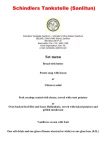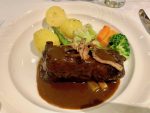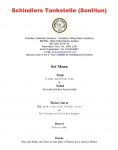17 August 2021
Here Rotary Beijing in Summer part 2! Back in Kempinski Hotel for our Tuesday lunch meeting. with a remarkable set of speakers, Charles and Kate Wang on the topic: “An Amputee’s Road to Full Recovery: A Personal Story”
This moving speech was about two people, who through personal experiences, witnessed and understood the challenges facing the amputees in China and took it upon themselves to provide the needed help. Charles, originally from China but sent away to the US at an early age, became a specialist in prosthetic rehabilitation, after received training from Duke and Northwestern University and worked at the Veteran’s Affairs Hospital in the States. Upon his return to China, he saw few people with disabilities, but the statics betrayed the true story of 3-5 million amputees.
Many were fitted with subpar prosthetics, and many of the younger amputees numbered 100,000, were fitted with ill-fitted adults’ components. There were no programs to help those amputees to regain their mobility or psychological counseling to deal with the aftermath of being amputated. They had been shunned and tucked away, neglected and ignored. Most of those amputees, after being deprived of their limps, were also denied education, jobs, or a normal life. So Charles teamed with Georg Hoffmann-Kuhnt, the prosthetics specialist from Germany and a long-time Beijing resident, to set up Morning Star to provide full-body rehabilitation, a facility very much lacking in China.
Kate, Charles’s wife, a native of Sichuan, was a teacher and trained as a dancer before losing both of her legs, as a result of having been buried under the rubbles for 30 hours during the Wenchuan Earthquake. After she recovered, Kate started a long journey of rehabilitation. While Kate recovered from the amputation, she found that many children were not so lucky. Many of those young children had difficulties adjusting to a life with disabilities and they could find no help, from the adults around them or society at large. There were no systematic programs in China to help people with disabilities to return to society, and Kate recounted many stories of the systemic prejudice and inconveniences many of the amputees faced. Kate was sent to Canada where for the first time, she was shown that being an amputee with well-fitting prosthetics, she could be who she wanted to be and do what she wanted to. She could swim, ski, run, and to her delight, even be taller, from having a height boost from her new legs!
The most important part of a leg prosthesis is the part that contacts the body, and this has to be handmade and fitted individually. At Morning Star, amputees, both adults, and young children are given professionally fitted prostheses, and importantly, they are given a second life to enjoy swimming, dancing, and other playful pursuits.
The two couples, Charles and Kate, Georg and Michelle, with their understanding of what amputees face in this harsh and hard society, are now devoting their professional expertise to providing professionally-made prostheses and supporting programs to help the amputees to rehabilitate, and recover their lost meaning of life.
24 August 2021
A small but cozy fellowship in Morel’s Restaurant, as many members were away or busy.
Teddy and Eddy joined the happy evening
31 August 2021
Another Kempinski lunch, with the induction of our new member Ralf and as speakers Celyn Bricker and Faye Lu on the topic “Protecting wildlife while staying at home”.
See an overview of their talk.
I enjoyed the mushroom soup and the roulade. Well done.






















































































































